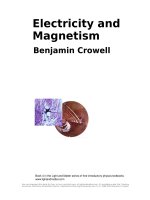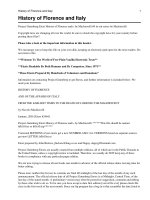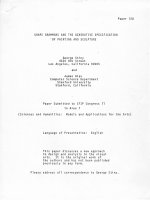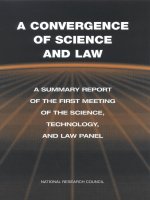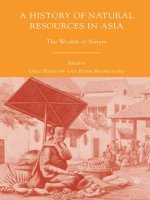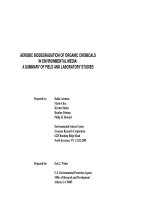A HISTORY OF ELECTRICITY AND MAGNETISM pot
Bạn đang xem bản rút gọn của tài liệu. Xem và tải ngay bản đầy đủ của tài liệu tại đây (26.3 MB, 343 trang )
A HISTORY OF
ELECTRICITY AND MAGNETISM
Burndy Library
Publication No. 27
A
HISTORY
OF
ELECTRICITY
AND MAGNETISM
Herbert W. Meyer
Foreword
by
Bern
Dibner
DÉVELOPPEMENT
ÉCONOMIQUE
ET
ÉTUDE
DES
MARCHÉS
CENTRE
DE
DOCUMENTATION
BURNDY
LIBRARY
Norwalk, Connecticut
1972
This book was designed
by The MIT Press Design Department.
It was set in IBM Composer Bodoni
by Science Press
printed on Mohawk Neotext Offset
by
The
Colonial Press Inc.
and bound by The Colonial Press Inc.
in the United States of America.
All
rights reserved.
No part of this book
may
be reproduced
in any form or by
any
means,
electronic or mechanical, including photocopying, recording,
or by
any
information storage and retrieval system,
without permission in writing from the publisher.
ISBN
0 262 13070 X (hardcover)
Library of
Congress
catalog card number:
70-137473
FOREWORD BY BERN
DIBNER
xi
PREFACE xv
1
EARLY DISCOVERIES
1
Archeology and Paleontology; Magnetite and the
Lodestone;
Thales
of Miletus; Ancient and Medieval Records, The Magnetic Compas;
William Gilbert.
2
ELECTRICAL MACHINES AND EXPERIMENTS
WITH STATIC ELECTRICITY 11
Otto von
Guericke;
Other
Expçriments
With Static Electricity;
Stephen
Gray and the Transmission of Electricity; Du Fay’s Experi-
ments and His Discovery of Two Kinds of Electricity; Improvements
in Electrical Machines; The
Leyden
Jar;
The Speed of Electricity; Sir
William Watson’s ‘Theories; Miscellaneous Discoveries; Benjamin
Franklin’s Experiments; Atmospheric Electricity; Experiments in
Europe with Atmospheric Electricity; Electrical Induction, Electro-
scopes; Other Discoveries in the Eighteenth Century
3
VOLTAIC ELECTRICITY, ELECTROCHEMISTRY,
AND
ELECTROMAGNETISM
34
Galvani's
Frog Experiments; Volta and the Voltaic Pile; Evolution
of the Battery and Discoveries with Electric Currents; Electromag-
netism; Ampère; Arago, Biot and Savart; Faraday's
Rotating
Con-
ductor
and Magnet and Barlow's Wheel; Sturgeon's Electromagnet,
Galvanometers;
Ampère's
and Ohm's Laws.
4
FARADAY AND HENRY 52
Faraday's Formative Years; Faraday Appointed to the Royal
Insti-
tution; Electromagnetic Induction; Other Contributions by Faraday;
Joseph Henry; Henry's First Excursions into Science; Henry Pro-
poses tbe Electromagnetic Telegraph;
Electromagnetic
Induction;
Self-Induction; Marriage and Professorship
at
Princeton; Electrical
Oscillations and Electromagnetic Waves; Other Researches; The
Smithsonian Institution.
vi Contents
5
DIRECT-CURRENT DYNAMOS AND MOTORS 71
Pixii’s Machine; Nollet’s Machines; Dynamos;
Electric
Motors.
6
IMPROVEMENTS IN BATTERIES
AND ELECTROSTATIC MACHINES 77
The Daniel1 Cell; The Grove Cell; the Leclanché Cell; Other Bat-
teries; Storage Batteries; Electrostatic Induction Machines.
7
ELECTRICAL INSTRUMENTS, LAWS, AND
DEFINITIONS OF UNITS 85
Tangent Galvanometer;
D'Arsonval
Galvanometer; Wheatstone
Bridge; Electrical and
Magnetic
Laws; Electrical and
Magnetic
Units.
8
THE ELECTRIC TELEGRAPH 95
Early Electromagnetic Telegraphs; Samuel F. B. Morse;
Demonstra-
tion of the First Morse Telegraph; Partnership with Alfred Vail; U.S.
Government Interested in Telegraph; Demonstrations of the
Im-
proved Morse Telegraph; Patent Applications; Submarine Cable;
Congress Appropriates $30,000 for an Experimental Line; Construc-
tion of the Line; “What Hath God Wrought!“; Commercial
Opera-
tion of the Telegraph; Construction of New Telegraph
Lines;
West-
ern Union; Printing Telegraphs; Relays; Duplex and Multiplex
Systems; Railway Telegraphs; The First Transcontinental Telegraph
Line; Electrical Manufacturing.
9
THE ATLANTIC CABLE
115
Early Submarine Cables; Newfoundland Cable; The Atlantic Cable;
Cable
Company
Is
Organized; Contracts for the Manufacture of
Cable; The Cable Fleet; Loading and Testing the Cable; Laying the
Cable; Project Postponed until the Following Year; Second Attempt;
Cable
Is
Spliced in Mid-Ocean; Insulation Breaks Down; The Second
Cable; Most of the Cable
Is
Laid Successfully Before It Breaks; The
Third Cable; The Siphon Recorder.
Contents vii
10
THE TELEPHONE
131
Bourseul
and
Reis;
Alexander
Graham
Bell; The Bell Family
Moves
to
Canada; Classes in Boston; The Harmonie Telegraph; Boston
Uni-
versity and George
Sanders;
Thomas A.
Watson;
The
Phonautograph
and
thc Reis Tclcphone; Meeting with Joseph Henry; Agreement
with
Sanders
and
Hubbard;
Bell's
Great
Discovery;
Despair:
New
Quarters; Tclcphone Patent Granted; Thc Telephone at thc
Centen-
nial
Exposition; Tcsting thc Telephone; Western Union Refuses
to
Buy
thc Telephone; Bell
Is
Married; Organization of Telephone
Companies;
Infringement
by the
Western
Union Telegraph Com-
pany;
Bell
Patent Upheld; Transmitters; Theodore N. Vail; Evolu-
tion of the
Bell
Companies;
The Dial Telephone;
Bell
Laboratories
and
Western Electric Company; Othcr Telephone
Systems.
11
ELECTRIC LIGHTING
152
Arc Lampa; Arc Lamp
Mechanisms;
Carbons;
Manufacturers;
Street
Liihting; Enclosed Are
Lamps;
Flaming Arcs; Incandescent Elcctric
Lights;
Edison's
Incandescent
Lamp;
Edison Electric Light
Com-
pany;
Menlo
Park; The Search for Better Filament Materials;
Im-
provements
in Lamp Seals and in Dynamos;
First
Commercial
Instal-
lations; Pearl
Street,
the First Central Station for Incandescent
Ligbting; Schencctady
Works;
Foreign Incandescent Liiht Installa-
tions; Improved
Lamps;
Othcr Types of
Lamps;
Metal
Filament
Lamps;
Tube Lighting; Fluorescent
Lamps;
Lamp Efficiencies;
Special-Purpose
Lamps.
12
ALTERNATING CURRENTS
177
The Transformer; Induction
Coils;
Gaulard and
Gibbs;
Westinghouse
Alternating-Current System; Alternating-Current Generators;
Fre-
quencies; AC-DC Conversion; Alternating-Current Motors; Niagara
Falls
Development;
Transmission
Lines;
Frequency and Voltage
Standards.
13
ELECTRIC TRACTION
190
Public Transportation; Rails and
Railways;
Street
Railways;
Electric
Propulsion; Electrification of Street
Railways;
Thc Carbon Brush;
viii Contents
Rapid Conversion from Horsecars to Electric Propulsion; Suburban
and Main Line Electrification; The
Decline
of Electric Street
Rail-
ways.
14
ELECTROMAGNETIC WAVES, RADIO,
FACSIMILE, AND TELEVISION
198
A Century of
Progress;
Hertz Discovers Electromagnetic Waves; Sig-
naling without Wires; Guglielmo Marconi; First Radio Patent;
Tuned Circuits; Continuous Waves; Detectors; The Edison Effect;
The Fleming Valve; De Forest Audion; Amplification; Armstrong’s
Oscillator Tube; The Alexanderson High-Frequency Generator;
Amateur Radio and Radio Broadcasting; Regulation of Radio; Fed-
eral Communications Commission; Frequency Allocations; Radio
Receivers; Facsimile Transmission; Commercial Facsimile;
Photo-
electric
Devices;
Pictures by Cable; Television; The Scanning Disk
and Mechanical Television; The Iconoscope; Improvements on the
Iconoscope; Transmission by Radio Waves; Regulation of Television
and Channel Allocations.
15
THE CROOKES
TUBE, XRAYS,
RADIOACTIVITY, STRUCTURE OF THE ATOM,
ACCELERATORS AND ATOMIC RESEARCH 224
The Crookes Tube; Vacuum Tubes before Crookes; Sir William
Crookes and His Experiments; Later Developments in Cathode
Rays; X Rays; Radioactivity; Scattering of Electrons; Photoelectric
Effect; Planck’s Constant; Photoelectrons and Einstein’s Equation;
Hydrogen Spectra; Structure of the Atom; Heavier
Atoms,
Elliptical
Orbits,
and Spin; Theoretical and Experimental Physics of the
1920s; Other Subatomic
Particles;
The Electron Microscope; Radia-
tion Detectors; Accelerators and Atomic Research.
16
MICROWAVES, RADAR, RADIO RELAY,
COAXIAL CABLE, COMPUTERS
253
Microwaves; Radar; Early British Developments and Installations;
American Wartime Research and Development; New Oscillators and
Other Tubes; Types of Radar; Other Uses of Radar; Telephone
Radio Relay; Frequency Band Allocations; Coaxial Cable;
Com-
Contents
ix
puters;
Computer
Development;
Digital and
Analog
Computer~;
Electronic
Computers;
Memory
Systems;
Input and Output
Sys-
tems;
Numeration.
17
PLASMAS, MASERS,
LASERS, FUEL CELLS,
PIEZOELECTRIC CRYSTALS, TRANSISTORS
275
Plasmas;
Masers
and Lasers; Gas Lasers; Applications; Electrolytic
and
Electrochemical Phenomena; Piezoelectricity; Solid
State
De-
vices; Semiconductors; Transistors; The Transistor
Industry.
18
ATOMIC ENERGY, GOVERNMENT RESEARCH,
NUCLEAR FUSION
289
Atomic Energy; Nuclear Research for the United States
Govern-
ment; Los Alamos Laboratory and the Atomic Bomb; Atomic
Energy Commission; Nuclear
Power
Plants; Nuclear Fusion; Whither.
BIBLIOGRAPHY
299
INDEX
307
FOREWORD
Of the many ages of man—the Stone Age, the Bronze Age,
the Iron Age, etc that preceded the 1800s, and that
led
one
into the other,
none
was
as rewarding to mankind as the
electrical age. We
now
stand in awe of the
space
age,
andin
fear we face the nuclear age. From electricity, however, has
been drawn an
ever
growing abundance of light, power,
warmth, intelligence, and medical
aid-all
beneficent, silent,
and
ready.
Electricity is the
one
force in the arsenal of man that
found no precedent in earlier history,
nor
was it drawn
from
classical
times. It is fully the fruit of the Enlighten-
ment, in timc and place, and it generated its own enlighten-
ment by extending man's waking hours and making him
master of his own dawn and night. With no more than the
touch of his
finger
he
can
summon energy
almost
without
limit
and
can
as readily
cancel
his summons. He
can
control
his environment, he cooled when he wishes it or be warmed
when needed. He can, in an instant, speak to anyone in any
location where the fine filaments that carry this
new
force
have
been extended. Ile can, at
will,
observe and
listen
to
public figures presenting problems of state or be enter-
tained by whatever his choice of talent might be. No czar or
emperor could command more.
With this
new
force man has probed the
universe
around
him and has
been
compelled to change his estimates of its
size exponentially. With radio astronomy he has penetrated
distances measured in billions of light-years.
He
has probed
the elemental nature of matter and energy; his genius
challenged by their complexity, he
devised
new
electronic
probes and analytical instruments. His networks of com-
puters
have
extended his intellectual powers (if not
xii Foreword
his wisdom) beyond
all
philosophic dreams. His weapons
of destruction are diffused in hundreds of locations
in the ground, in the
sea,
and in the air,
each
weapon’s
destructive strength measured in the equivalent megatons
of explosive and
all
controlled by electrical energy
equiva-
lent to the power of a flea, the signal traveling
over
a hot
line.
With
such
knowledge,
such
power,
such
control of
envi-
ronment, and such fleet means of communication, man has
demonstrated his ability to reach the moon, travel its harsh
surface, and return to earth-recording and televising his
position, observations, and thoughts during the entire jour-
ney.
This, and more, was realized in only a little more than
a decade from the decision to attempt
such
a difficult mis-
sion.
Admittedly, the acquisition of electricity as an instrument
of power and control in the inventory of man's abilities was
no small addition. One
can
therefore stop and inquire about
the circumstances that brought this acquisition about and
review the events and personalities whose labors revealed
the characteristics of a force unknown throughout the
ear-
lier millenia of work and study.
Two events ushered in the interest that blossomed into the
arcane realm of electricity and magnetism. The first was the
publication in London of a book on electricity and magne-
tism written by the physician to Queen Elizabeth who had
devoted his leisure time and much of his fortune to investi-
gating the properties of magnets and electrified bodies.
Dr. William Gilbert’s book, De Magnete, was published in
Latin in 1600; its strength lay in the thoroughness with
which the author examined
each
claim made in earlier writ-
ings on electrical phenomena, magnets, and compasses and
in the exhaustive experimentation that separated the
undis-
Foreword
xiii
puted results of his observations from the
accumulated
superstitious claims of the past. This launched the science
of electricity and magnetism from a firm
basis
of perfor-
mance derived from objective
experimentation.
The second event of significance that pushed electricity
ou its way toward usefulness was an
announcement
made in
1800 by Alessandro Volta that a new form of electricity
could be drawn from a pile of
alternating
zinc and silver
disks stacked one on the other, each pair separated from
thc adjoining pair by a cloth or
paper
disk saturated in
brine. From the ends of this pile, Volta could draw a con-
tinuously flowing electric current, which he and others
soon used
to
decompose water, to cause charcoal to glow
with intense light in au electric arc, and, later, to deposit
metals
by electrolysis.
These two events-Gilbert's book on magnetism (1600)
and Volta's constant-current clectric cell
(1800)-represent
two çenturies that neatly bracketcd the nascent phase of
electrical development.
The
one formulated more accurate
knowledge
about
a force then useful for navigation in an
era of voyaging and exploration; thc other çhanged the con-
cept of electric generation from frictional clectricity, giving
off bigger and bigger sparks, into an
electric
source of vast
potential. However, the period must not be closed without
tribute being paid to Franklin, an intrepid experimenter,
who ideutified lightning as electricity and with his lightning
rod helpcd rescue mankind from the
terror
of destroyed
homes, steeples, and other structures. At the same time he
helped guide man's faith to the
truer
character
of natural
forces and away from the
ancient
superstitions
about
light-
ning and the gods’ intentions.
The
next
important step on the ramp of electrical progress
was
the
discovery by Oersted in 1820 that a wire connect-
xiv Foreword
ing the ends of a voltaic pile was enveloped by a magnetic
field. It was then found that if
such
a wire were looped into
a
coil
the magnetic strength was greatly intensified. With
such
a magnetic field Faraday showed, in 1831, that a
moving electrical conductor had an electric current induced
in it; the electric generator and its important adjunct, the
transformer, were thus born. The generator supplied
elec-
tric current in abundance and with this and auxiliary cur-
rent from electric batteries the electric telegraph
devel-
oped-the first important instantaneous disseminator of
human intelligence
over
long distances. There followed
the laying of the first transatlantic table, the telephone, the
electric lamp, and the electric motor. Each development
generated a family of by-products-electroplating, the
elec-
tric trainway, the moving picture-and
each
created a cor-
responding major industry.
As the drama of electrical development unfolds, we relate
each
forward step to the genius and
perseverance
of some
experimenter, some inventor, some innovator. TO him
should go
all
the honor of a grateful people, for these are
the true heroes of the modern world. The pages that follow
will
unfold their story, their struggles and attainments.
May
the telling
never
end.
Bern Dibner
PREFACE
PURPOSE OF BOOK
It is the
purpose
of
this book to attempt to
give
to the
reader, who
has
arrived
upon
the world
scene
in the midst
of a scientific explosion, a
sense
of perspective and direc-
tion. The word explosion as it is used here is not entirety
accurate
because
it implies a
sudden,
violent, and
instanta-
neous
event.
The burgeoning of science resembles more
nearly the propagation of a
new
grain
from
a few
seeds,
to a
few bushets, and finally to a tremendous
harvest.
A history
such
as this might be presented as a collection of
biographies or
as
a
series
of stories concerning inventions
and discoveries. It could discuss the unfolding of
events
from the standpoint of pure science or it might be weighted
on the
side
of technotogy. Att of these considerations
have
played a part in tbe writing of this story. Hopefutty the
book has blended these differing viewpoints in
such
a
way
as to stimutate the interest, not
only
of the student of
science, but
also
that of the
casual
reader, who finds him-
self surrounded by the fruits of science and technology,
knowing not from whence they came.
EXPERIMENTAL AND THEORETICAL RESEARCH
During the
early
period of the development of electrical
and
magnetic science, beginning with William Gilbert and
Otto von Guericke, discoveries were the result of experi-
ment coupted with observation and interpretation. At
about the same time there
began
a different kind of
scien-
tific exploration
based
largely
on mathematics, exemptified
by Kepler's planetary
laws
and Newton's laws of motion. In
etectrical science mathematical analysis
based
on experi-
xvi Preface
ment came a little later in the work of
such
men as Ampère,
Coulomb, Biot and Savart, Gauss, Weber, and Ohm.
Maxwell, an ardent admirer of Faraday’s great genius,
in-
terpreted Faraday’s discoveries mathematically and contrib-
uted his own mathematical findings, but credit for some of
Maxwell’s discoveries must be shared with Helmholtz,
whose versatility in science has rarely been equaled. After
Maxwell and Helmholtz followed a period of twenty or
more years of fruitful experimentation. As a result of
the Michelson-Morley experiment, Lorentz and Einstein
brought forth new concepts of length and time that seri-
ously upset the Newtonian system. Under the new theory
length and time were no longer absolutes but were relative,
and Newton’s laws were valid only as
special
cases. Even
more upsetting was the suggestion that matter and energy
were convertible,
one
into the other.
These great triumphs of theoretical science were only a
beginning, and there was much more to corne. The nature
of matter and energy became the primary object of physical
research with most astonishing results. This type of research
began with the work of J. J. Thomson, Planck, Lenard,
Moseley, Rutherford, and Bohr, followed a few years later
by the astonishing revelations of A. H. Compton, C. T. R.
Wilson, de Broglie, Schrodinger, Heisenberg, Pauli, Born,
Dirac, Davisson, Germer, G. P. Thomson, and Kikuchi.
MERGING OF THE PHYSICAL SCIENCES
As the nature of matter and its relationship to energy
be-
came clearer, the gaps between the branches of physical
science began to close, and the lines of demarcation became
indistinct. It is therefore difficult in a work
such
as this to
avoid being drawn into by ways only remotely connected
with the subject matter.
xvii
Preface
ACKNOWLEDGMENTS
The author wishes to express his appreciation for the en-
couragement and suggestions given by Dr. R. J. Collins,
head of the Department of Electrical Engineering of the
University of Minnesota, and especially for important help
given
by Dr.
W.
F. Brown, professor of Electrical Engineer-
ing,
also
at the University of Minnesota.
I
also
owe a debt
of gratitude
to
my
wife, Elfriede, for her valuable assis-
tance.
1
Early Discoveries
ARCHAEOLOGY AND PALEONTOLOGY
Reçorded political history now
reaches
back to
about
4000 R.C., but
we
have some
knowledge
of mankind of
much
earlier
periods based on the findings of archaeologists
and paleontologists, aided by the studies of anthropologists.
Prehistoric man fashioned weapons,
tools,
utensils, and
clothing from stone, shells, bone, wood, skins, and sinews.
Later he learned
to
use
metals,
such as copper and gold,
which were found in their native state and required no
smelting. Bronze, which is usually an alloy of copper and
tin. carne into use in Europe by the year 2000 B.C., or
perhaps earlier, and gave rise to the period known as the
Bronze Age.
There is no reliable record as to the date when the smelt-
ing of the ores of copper, tin, lead, and zinc began, but
these
metals
were definitely in use before the beginning of
the Christian Era. The Romans mined copper or copper
ores in Cyprus and later obtained tin from
Cornwall
in
England.
It is
difficult
to
determine the date of the earliest iron
implements, but iron artifacts have been
found
in Egypt
dating back to 4000 B.C.
Iron
in its native state occurs only
in
meteorites
and in tiny needles sometimes found in ba-
salts. Little is known as to the date when man first pro-
duced iron from ores, but there is evidence that by 1350
B.C. the Hittites in Asia Minor succeeded in reducing the
oxides
of iron.
MAGNETITE AND THE LODESTONE
There are probably few natural materials known today that
were not also known to prehistoric man,
although
he had
2 Chapter
One
little knowledge of their uses. Among the rather widespread
and fairly abundant minerals of the earth is a very useful
ore of iron called magnetite, which has the composition
Fe
3
O
4
. It is a crystalline minera& very dark in color, having
a metallic luster, and a specific gravity equal to
about
five-
sevenths of that of iron. Unlike any of the other iron ores it
is magnetic, and this property gives it its name. There are
occasional pieces of magnetite, as found in nature, which
are permanently magnetized, and such pieces are known as
loadstones or lodestones. In some specimens the magnetism
is sufficiently strong to enable them to lift several times
their weight of iron from one pole. There is good reason to
believe that the attractive powers of lodestone had been
observed as much as 3000 years before the Christian Era,
but the directive properties of freely suspended pieces were
probably not known until much later.
We are told that Huang-ti, or Hwang-ti, or Hoang-ti, an
emperor of China in the year 2637 B.C., had a chariot upon
which was mounted the figure of a woman, pivoted or sus-
pended SO that it was free to turn in any direction. The
outstretched arm of the statue pointed always to the south
under the influence of concealed lodestones.
Similar magnetic cars are mentioned by Chinese historians
at various times down to the early centuries of the Christian
Era. The Chinese also discovered that steel needles could be
permanently magnetized by the lodestone and used as com-
passes. According to Humboldt, Tcheou-Koung, Chinese
minister of state in 1110 B.C., used a compass employing a
steel needle, and the same authority relates that Chinese
mariners with the aid of compasses navigated the Indian
Ocean, in the third Century A.D.
Unlike the
ancient
civilizations of the West which per-
ished, the Chinese civilization has continued in an almost
unbroken
line down-to the present time,
so
that its recorded
history is
far
more complete than that of Babyton or Egypt.
‘There
is some disagreement among scholars as to whether
or not the stories concerning thc use of magnetic chariots
or magnetic needles, by the Chinese, is fact or fiction.
Since, however, such devices are possible, and since such
stories recur from time to time in Chinese history and leg-
end, there seems to be little reason to rcject them.
THALES OF MILETUS
In 600 H.C. Greek civilization and commerce were
flourish
ing. On the Grecian peninsula the City-states of Athens and
Sparta hûd grown to greatness and power. Numerous Greek
colonies had been planted on tbe shores of the Mediter-
ranean a Aegean seas, amorrg whicb was Ionia in Asia
Minor. Miletus was a thriving seaport in lonia, in and
out
of
which sailed ships from all of the ports of the Mediter-
ranean. Its inhabitants, through their trade with other coun-
tries, became well-to-do and
acquired
much of the culture
of
other
civilizations o
f the Mediterranean basin. Philos-
ophy, astronomy, mathcmatics, poetry, and art were culti-
vated along with commerce.
One of thc inhabitants of Miletus in the year 600 B.C.
was
the philosopher Thales
(640?-546
B.C.). A contemporary
of Draco, Soton, and of King Nebuchadnezzar of Babylon,
he was the founder of the
Ionian
school of philosophy from
which Socrates came. Thales traveled extensively and re-
ceived an important part of his education from the priests
at Memphis and Thebes in Egypt. From them he learned a
great
deal
about
the physical sciences and geometry, andin
the latter he
soon
exce
II
e
d his teachers. Thales's life was
devoted to teaching, discussion, philosophy, and statecraft.
Unfortunately for posterity he
left
no writings, and all that
4 Chapter
One
we know of him was transmitted orally until Aristotle
re-
corded his teachings.
Thales is important in electrical history because he was the
first
person
who is said to have observed the electrical prop-
erties of amber. He noted that when amber was rubbed it
acquired the ability to pick up light objects,
such
as straw,
dry grass, and the like. He also experimented with the lode-
stone and knew of its power to attract iron. He apparently
associated the two phenomena, although more than twenty-
four hundred years elapsed before
any
actual
relationship
was proved. We do not know whether Thales discovered
these facts for himself or learned of them from the
Egyp-
tian priests or from others. He apparently did not know of
the directive power of the lodestone.
It is from the Greek that our terms electricity and magne-
tism are derived; the Greek word for amber is
ελεκτρον
(elektron), and the word magnet is thought to have corne
from Magnesia, a district in Thessaly, in which lodestones
were found. According to Pliny, however, the word is
de-
rived from Magnes, the name of a shepherd who observed
that the iron on the end of his crook was attracted by
certain stones on Mount Ida that proved to be lodestones.
ANCIENT AND MEDIEVAL RECORDS AFTER THALES
The earliest written record that mentions the electrical prop-
erties of amber came from Theophrastus (about 300 B.C.).
Later, various other Greek and Roman writers alluded both
to the electrical properties of amber and the magnetic prop-
erties of the lodestone. Pliny the elder (23-79 A.D.), a
Roman naturalist whose untimely death occurred on the
seashore at Retina not far from Pompeii, in the eruption of
Mount Vesuvius, referred to the attractive powers of
amber several times in his Natural
History.
He wrote that
the Etruscans, about 600 B.C., were ablc to
draw
lightning
from the clouds and to turn it
aside.
We learn from others
that the Temple of Solomon may
bave
been protected from
lightning hy
nurnerous
Sharp
points of metal that
covered
the roof
and
that were connected by means of pipes to
çaverns
in a hill. The temple of Juno is said to
bave
been
similarly protected. Lucretius, the poet and author of De
Rerum
Natura,
noted the ability of the lodestone to attract
several
iron rings, onc adhering to the other, and marveled
at the peculiar
behavior
of iron filings in a
brass
bowl when
a magnet
was
moved ahout heneath,it.
As the gxat Roman Empire declined, the culture of
Greece and Rome gradually
vanished;
Learning almost
dis-
appeared and for centuries was confined largely to the
monks and prie& ib
the
Christian çhurch. After the
rise
of
Islam, in the early part of the
seventh
Century, there
was
a
great
upsurge
in learning among the Arab
peoples,
who,
even
though they destroyed the library at Alexandria,
trans-
lated the works of the great
pagan
philosophas. Arab cul-
ture flourished during the Dark Ages when Western learning
was
at low ebb, where it remained until the beginning of
the Renaissance.
There is an interesting item from
Chinese
history during
the early part of
our
era. Koupho (295-324 A.D.), a
dis-
tinguished
Chinese
naturalist, compared the attractive
power of the magnet with the ability of excited amber to
attract mustard seeds. From his mariner of writing, it
ap-
pears that this property of amber was no
new
discovq,
but it is tbe first time the phenomenon
was
mentioned in
Chinese
history.
During the Middle Ages the properties of amber and the
lodestone were not forgotten, but no
new
knowledge was
added. St.
Augustine
in 426 A.D. expressed wonder at the
6
Chapter
One
ability of the lodestone to hold several iron rings suspended
from it, and he mentioned an experiment in which a bit of
iron laid on a silver plate is made to follow the movements
of a magnet beneath the plate.
That long and dismal period of European history, gener-
ally called the Dark Ages, or the Middle Ages, came to an
end sometime during the thirteenth or fourteenth centuries.
In the world of science there may be some disagreement as
to who was the first real scientist in the
revival
of learning,
but surely Albertus Magnus
(1206?-1280)
was among the
earliest. He taught at the University of Paris, where he was a
distinguished professor of theology and philosophy and was
also among the most learned in the science of the day. Also
at the University of Paris at the same time was Roger Bacon
(1214?-1294), who had first studied at Oxford. He became
well versed in the scientific works of the Greek
philoso-
phers and the Arab scholars. It was Roger Bacon, more than
anyone of his time, who insisted that human progress
de-
pended upon research and scientific education. His
re-
searches
carried him into the fields of alchemy, medicine,
optics, and mathematics. He is sometimes credited with the
invention of the telescope and of gunpowder, although the
former is generally ascribed to Lippershey of Middleburg,
Holland and the latter to Berthold Schwartz.
In Roger Bacon’s greatest work, his Opus
Mujus
(1268), he
reversed the manner of thinking of the Greek philosophers,
which was largely subjective, to reasoning based on experi-
ment. His writings and experiments, however, got him into
trouble with the Church and he was
accused
of practicing
black magie. He had become a Franciscan monk upon his
return to England in 1250 but was soon enjoined by his
order from writing or teaching and thereupon returned to
Paris, where later the ban was lifted by a new pope.
THE
MAGNETIC
COhtPASS
One
of
Koger
BacOn’s
teachers
was
Petrus Peregrinus, or
Pierre de Maricourt, who
had
carricd on numerous experi-
nxmls in rnagnetism. Petrus Peregrinus
M-as
net only a
teachcr but
also
a
soldier
attached
LO
~he
engineer corps of
the Frencb army. During thc year 1269, while he
wa
with
the
armies of Charles of Anjou, which were besieging
Lucera in southern Italy:
he
wrote a lengthy
lelkr
from bis
camp to a friend named
Sigerus
de Foucancour~, at his old
home in Picardy.
‘Thc
letter described in detail bis experi-
ments with
magnetü,
lhe construction of a floating com-
pas, and
also
a pivoted compas employing
a
steel
ncedlc.
This compas
was
provided with a tard net unlike
the
mari-
ner’s
compass of today. An excellent translation of
Pere-
griuus’s
Ieller has been made by Professor
Silvanus
P.
Thompson.
The Italian historian
Flavius
Blondus writcs that Italian
rnariners,
sailing out of the harbor at Amalfi, used a floating
magnet as a compas before 1269. Its invention
was
attrib-
uted to
a
fiçtitions
person
named Flavio Gioia of Amalfi.
Therr is an inconsistençy, however, in this account
because
the alleged invention oçcurred in 1302. Blondus
asserts
that
the
real
origirr
of the magnetic
compass
is unknown. There
seems to
be
litlle doubt that thr Italiaos learned about lbe
compas from the
Arabs.
The magnetic compas
wâs
the first
device
having
practical
value that came from experiments with magnetism. After
the tirne of Petrus Peregrinus the compas
soon
carne into
general
use and
led
to many theories as tu the rasons for
its behavior. Its variations in diffcrcnl longitudes were
noted, togçther with other changes of short duration.
IJn-
doubtedly the voyages of Columbus and
Vasço
da
Gama
were greatly aided by its
use.
